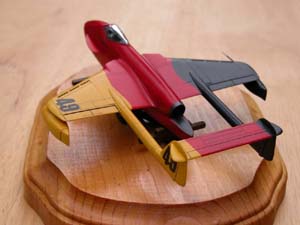1949 Schneider Cup Racer
Focke-Wulf SeeFlitzer Marx 1
|
 |
History
In Bremen, Germany in March 1943, Focke-Wulf initiated a series of
design studies for single-seat, jet powered fighters. One promising design,
Projekt VII, was given the code name "Flitzer". It mounted wings of moderate
sweep, with twin booms and a high mounted tailplane. A single HeS 011A
turbojet (3300 lb static thrust) was to be supplemented during takeoff
with a small rocket mounted below the jet, but the rocket was later abandoned.
 The
Flitzer was well advanced in development, including a full-size mock-up
and fabrication of some prototype sub-assemblies. The project was cancelled
in late 1944 because, although using only a single turbojet, the Flitzer's
performance was estimated to be similar to the Me 262 which was already
entering service. The
Flitzer was well advanced in development, including a full-size mock-up
and fabrication of some prototype sub-assemblies. The project was cancelled
in late 1944 because, although using only a single turbojet, the Flitzer's
performance was estimated to be similar to the Me 262 which was already
entering service.
Racer Development
 Knowing
that the 1949 Schneider Trophy Race would be a prestigious venue to promote
their "influence" on eastern Europe, the Soviet Union provided substantial
financial and technical support to the East German Communist Party effort.
The elegant and futuristic appearing Flitzer design of 1944 was resurrected
as a platform to showcase the technological prowess of the newly formed
Deutsche Democratic Republic (DDR). Knowing
that the 1949 Schneider Trophy Race would be a prestigious venue to promote
their "influence" on eastern Europe, the Soviet Union provided substantial
financial and technical support to the East German Communist Party effort.
The elegant and futuristic appearing Flitzer design of 1944 was resurrected
as a platform to showcase the technological prowess of the newly formed
Deutsche Democratic Republic (DDR).
 For
the '49 Schneider racer, dubbed the SeeFlitzer Marx 1, thrust was significantly
increased (to 5952 lb static) by the addition of a VK-1 (modified Rolls-Royce
Nene) engine, as developed for the MiG-15 fighter. A hull was integrated
with the fuselage, and outrigger floats fitted to the wingtips. Forward
body strakes were installed to inhibit water spray ingestion into the
engine inlets during taxi, takeoff, and landing, which in turn necessitated
the addition of fixed horizontal tail fins to (mostly) restore longitudinal
stability. Empty weight was approx. 6000 lbs, with significant fuel volume
available to store the approx. 1500 lbs of fuel required to run the race
distance. For
the '49 Schneider racer, dubbed the SeeFlitzer Marx 1, thrust was significantly
increased (to 5952 lb static) by the addition of a VK-1 (modified Rolls-Royce
Nene) engine, as developed for the MiG-15 fighter. A hull was integrated
with the fuselage, and outrigger floats fitted to the wingtips. Forward
body strakes were installed to inhibit water spray ingestion into the
engine inlets during taxi, takeoff, and landing, which in turn necessitated
the addition of fixed horizontal tail fins to (mostly) restore longitudinal
stability. Empty weight was approx. 6000 lbs, with significant fuel volume
available to store the approx. 1500 lbs of fuel required to run the race
distance.
 The
SeeFlitzer was an unabashed propaganda machine. A German tri-color flag
was gaudily emblazoned on the vehicle, which boldly flashed to spectators
during hard left turns (Note: the "hammer & compass" symbol was not added
to the DDR flag until 1959). Sharp-eyed viewers could make out a heavy
handed portrait of Karl Marx on the lower wing. The number 49 was chosen
as a fitting race number to commemorate the official establishment of
the DDR government just weeks before the 1949 Schneider Trophy Race. The
SeeFlitzer was an unabashed propaganda machine. A German tri-color flag
was gaudily emblazoned on the vehicle, which boldly flashed to spectators
during hard left turns (Note: the "hammer & compass" symbol was not added
to the DDR flag until 1959). Sharp-eyed viewers could make out a heavy
handed portrait of Karl Marx on the lower wing. The number 49 was chosen
as a fitting race number to commemorate the official establishment of
the DDR government just weeks before the 1949 Schneider Trophy Race.
Major Gerhard von Schwerwasser, a test pilot with considerable experience
at the Rechlin test center during the war, and a DDR Communist Party loyalist,
was assigned as project pilot. It was he who would take the SeeFlitzer
to battle over the Firth in October, 1949.
Model Information
 The
1949 SeeFlitzer model is based on the Revell-Germany Focke-Wulf Flitzer
kit. The main hull comes from an Aeroclub 1/72 scale float set, cut down
and faired with the lower fuselage. Outrigger floats are from an old Jo-Han
1/72 A6M2 Zeke/Rufe kit. The forward body strakes and horizontal tail
fin additions are from sheet styrene. Main landing gear doors were faired
smooth. The
1949 SeeFlitzer model is based on the Revell-Germany Focke-Wulf Flitzer
kit. The main hull comes from an Aeroclub 1/72 scale float set, cut down
and faired with the lower fuselage. Outrigger floats are from an old Jo-Han
1/72 A6M2 Zeke/Rufe kit. The forward body strakes and horizontal tail
fin additions are from sheet styrene. Main landing gear doors were faired
smooth.
Decals were custom made using the SuperCal system for inkjet printers.
See the SeeFlitzer and other 1949 Schneider Trophy Race models at the
IPMS/Seattle Spring Show, April 16, 2005 at the Renton Community Center
in Renton, WA.
|
|
